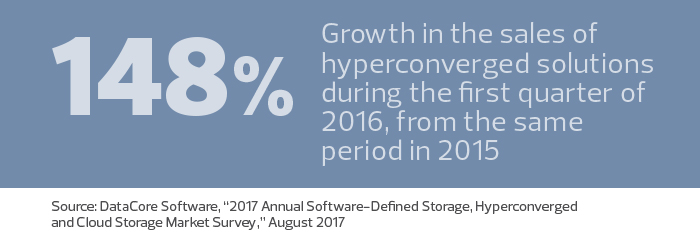Fact or Fallacy: Can Hyperconvergence Scale Enough to Help Feds?
Hyperconverged infrastructure is more than a buzzword; it’s a way to dramatically reduce management costs and complexity associated with data center virtualization. But because HCI is based on low-cost commodity hardware, the technology can make IT managers nervous about reliability and scalability.
This can lead to confusion over whether hyperconvergence is a valuable hardware solution or merely a short-lived fad. Federal IT leaders should understand which claims about hyperconvergence are fallacies, and which are fact.
SIGN UP: Get more news from the FedTech newsletter in your inbox every two weeks!
Fallacy: HCI Cannot Match Dedicated Storage Area Network Systems
Many IT managers favor SANs when building virtualization farms. Separating disks from servers makes components easier to manage and upgrade. HCI bucks that trend, combining compute engines and storage.
This may seem like a step backward, but in a hyperconverged deployment, the software intelligently manages storage. For example, hyperconverged storage leads to higher performance when workloads are properly distributed. A well-designed management system smooths over the difficult problems IT managers often face in matching applications, servers and storage.
In addition, the lower cost of server-attached storage brings high-performance technology such as solid-state drives within budget reach. SSDs allow for tiered storage levels, which can be managed automatically.
Agency IT professionals should keep in mind that some computing loads won’t work cleanly with a distributed storage system. However, most general-purpose applications, including databases, fit well with HCI.
Fallacy: Hyperconvergence Is All About Hardware, so Fastest Is Best
The strength of hyperconvergence is software that integrates server resources, storage and networking. Hardware is part of the equation, but it’s a less important part. Because hyperconvergence follows the concept of modular scalability, speeding up the infrastructure requires only dropping more nodes into the mix.

A key feature that IT managers should look for in a hyperconverged solution is an architectural ability to boost processing and storage power by simply adding nodes without having to re-engineer other hardware. With the rise of virtualization in enterprise data centers, IT shops have a built-in workload for HCI systems, as most data centers have multiple applications running on multiple servers.
Fact: HCI Can Create Challenges in How Agencies Run Data Centers
Hyperconverged solutions marry previously separate areas of data center management: networking, storage, virtualization and server management. With HCI, all four are combined into a single system. For data center teams that once worked in silos and were rigidly broken up into separate groups with separate areas of expertise, hyperconvergence changes the paradigm.
IT managers must strategize with their teams to deal with this change. IT staff members who don’t buy in to the new environment won’t be able to take full advantage of the new architecture.
Fallacy: HCI Is a Quick Replacement for Racks of Servers and SANs
Hyperconverged infrastructures are designed to quickly and easily bring up servers, virtual machines and their associated networks and storage. Once IT professionals start managing VMs through the graphical interface of a hyperconverged infrastructure, they see how fast and easy it is to scale and manage.

In addition to staff friction related to new technology, plenty of other issues in data center management may surface when commodity hardware replaces specialized systems. For example, disaster recovery/business continuity technologies may depend on specific checkpoint or replication capabilities of a vendor’s SAN. When that SAN’s workload changes, the entire recovery plan must be revisited, which is an expensive and time-consuming chore.
Fortunately, many IT managers have already begun to restructure their processes to better incorporate virtualization technologies. Since hyperconverged infrastructure is tightly tied to virtualization, the more virtualization-friendly an agency’s processes and policies are, the faster it will be able to reap the benefits of hyperconvergence.









